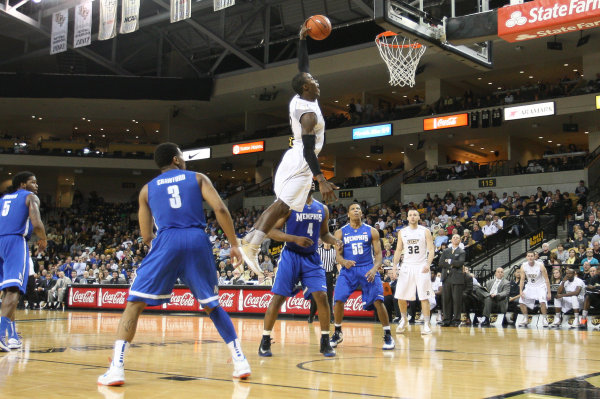AAC Team Previews: Central Florida Knights
Posted by CD Bradley on November 4th, 2013Our team preview style has been heavily cribbed from the microsite writers over in the Pac-12. We love them and assume they would take our attempt at loose imitation as flattery and not plagiarism.
Central Florida
Strengths: Experience and flexibility. The Knights’ starting lineup is made up of five returnees, all of whom averaged at least 20 minutes per game for a 20-win team last season. Their best player, 6’6” Isaiah Sykes, led the team in scoring, assists and steals and was second in rebounding last season, and can play four positions. Their center by default, 6’7” Kasey Wilson, led Conference USA in three-point shooting last season, making 42-of-84 from long range. That versatility could cause match-up problems for some teams and put the Knights in numerous advantageous scoring positions.

Isaiah Sykes, the do-everything wing for Central Florida, will have to do even more this season. (ucfknights.com)
Weaknesses: Defense and rebounding. Even with all the returning players, UCF has one big loss to overcome: center Keith Clanton, the school’s all-time leading rebounder, who pulled down nearly a quarter of the team’s rebounds last season and nearly half its blocks. But even with him, the team still allowed opponents to shoot 49.4 percent on two-point attempts (good for #239 in the country, according to KenPom.com) and to grab 33.1 percent of rebounds on the defensive end (#229 nationally). Without Clanton, a team that allowed foes to make too many close shots and rebound too many of the few they missed is going to have some major problems. Unless 6’8” JuCo star Eugene McCrory can make a big difference at the defensive end, the Knights don’t look to have many answers.
Schedule: The non-conference slate offers only one real opportunity for a marquee win, and it’s very early on when Florida State visits Orlando on November 13. Otherwise it’s possible the Knights won’t face another top 100 RPI team before conference play (although it’s not necessarily their fault that a road game at Miami (FL) the week before Thanksgiving won’t feature Shane Larkin). AAC play starts with a bang, with preseason favorite Louisville visiting Orlando on New Year’s Eve. The conference slate is front-loaded, though, as they close with at Houston, Rutgers, at SMU, at Temple and Houston.
If Everything Goes Right: After knocking off Florida State (who goes on to finish in the top half of the ACC), the Knights escape their non-conference schedule unscathed, or close to it. Holding their own in the AAC, they manage to steal a win against one of the AAC’s top three (maybe UConn on February 9) before closing out strong. McCrory helps paper over the interior holes, and the AAC’s backcourt-dominant teams can’t take advantage. The Knights win 20 games for the fourth straight year and make Selection Sunday interesting.
If Everything Goes Wrong: The Knights lose to the Seminoles, as well as at Miami and Valparaiso. They get blown out by Louisville on New Year’s Eve, falling like a stone to the bottom of the conference standings. Teams run a layup line through their porous defense, and follow-slam any stray layups. The Knights play better in February, but it’s too little too late, and they end up near the bottom of AAC and close to 20 losses.
What Will Happen: The Knights get a win over Florida State (who finishes as an ACC also-ran), but drop a couple of games against middling-at-best teams before AAC play begins with a never-close loss to Louisville. They muddle through conference play, winning one they shouldn’t and losing one they should. At the end, they finish in the bottom half of the AAC and around .500 for the season.










































